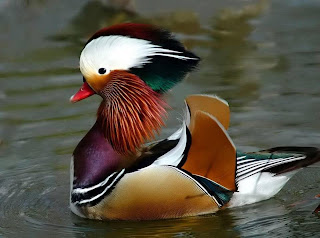 Is there anything cuter than a duckling? And, again, in this cute little bird resides an amazing display of God's design.
Is there anything cuter than a duckling? And, again, in this cute little bird resides an amazing display of God's design.Ducks, as it turns out, are, like some of our wrist watches, "water resistant". They are nearly waterproof. This isn't true of all birds, but it is essential for water birds. Ducks have a special feather structure that provides sealing along with a waxy coating from a special gland that the duck spreads on the feathers while preening.
There are basically two methods that ducks use to eat, each specific to types. Some breeds eat at the surface, called "dabbling". Mallards and Teals are examples. These will either eat off the surface or dunk themselves under with tails in the air to get a little beneath the surface. Then there are the "divers", the ones that can go completely under and feed at the bottom of the pond. Mergansers do this, as well as Goldeneyes, Widgeons, and other ducks. Here's the funny thing. In some cases baby ducks find themselves being raised by other duck breeds. So a Canvasback (diver) might find itself without a family and being raised by a Mallard (dabbler) mother. This little tyke will swim along with its adopted siblings and do everything they do ... except it will eat as its parents did. Without ever being trained, divers will dive and dabblers will dabble and never the twain shall meet.
A duck's bill is specially designed. It is broader than other birds and includes a comb-like structure on the sides because, after all, ducks forage in mud and such and need to strain food through this structure to get the algae, insects, and crustaceans they eat.
 |
| Mandarin Duck, typically found in southeast Asia |
There are more than 100 species of ducks in the world, with many being uniquely specialized for different habitats and conditions. They are found on every continent except Antarctica, anywhere water (marshes, lakes, rivers, oceans) is found. They have feet designed for swimming, bills designed for their particular method of eating, feathers designed for their watery lifestyle, and can be really cute. Try to express all that without the word "design" in it.
No comments:
Post a Comment